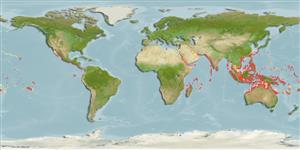Environment: milieu / climate zone / depth range / distribution range
البيئة
بحري مرتبطة بالشعاب; نطاق العمق 1 - 40 m (Ref. 9710), usually 10 - 25 m (Ref. 27115). Tropical; 24°C - 28°C (Ref. 27115); 30°N - 23°S, 180°W - 180°E
Indo-Pacific: Red Sea south to East London, South Africa (Ref. 5469) and east to the Marquesan Islands, north to the Mariana Islands, south to New Caledonia. Eastern Pacific: Gulf of California to Colombia and the Galapagos Islands (Ref. 9289).
الحجم / وزن / العمر
Maturity: Lm ? range ? - ? cm
Max length : 10.0 cm TL ذكر/ مختلط الجنس; (Ref. 9289)
الأشواك الظهرية (المجموع) : 10; الأشعة الظهرية الناعمة (المجموع) : 12 - 13; شوكة شرجية: 3; أشعه شرجية لينه: 6. Highly variable in color from pale with grey to black blotches to pink with bright red blotches (Ref. 48636). Pale with horizontal rows of subquadrate dark brown spots; a row of smaller spots on LL between larger spots; small dark brown spots on head (Ref. 5469).
Inhabit areas of rich coral growth and clear water of lagoon, channel, or seaward reefs from below the surge zone to depths of at least 40 m. They rest on, in, or beneath hard or soft corals. Feed on crustaceans and small fishes (Ref. 37955). Males are territorial and haremic (Ref. 37816).
Life cycle and mating behavior
النضج | التكاثر | وضع البيض | بيض | الخصوبة | Larvae
Pelagic spawner (Ref. 31569). Spawning ascents into the water column occurred over a distance of 0.3 to1.0 m (Ref. 26305).
Randall, J.E., G.R. Allen and R.C. Steene, 1990. Fishes of the Great Barrier Reef and Coral Sea. University of Hawaii Press, Honolulu, Hawaii. 506 p. (Ref. 2334)
IUCN Red List Status (Ref. 130435: Version 2024-2)
استخدامات بشرية
مصائد: تجاري; حوض مائي: تجاري
أدوات
تقارير خاصة
Download XML
مصادر علي الأنترنت
Estimates based on models
Preferred temperature (Ref.
123201): 23.2 - 25.9, mean 24.9 °C (based on 42 cells).
Phylogenetic diversity index (Ref.
82804): PD
50 = 0.5039 [Uniqueness, from 0.5 = low to 2.0 = high].
Bayesian length-weight: a=0.01549 (0.00909 - 0.02638), b=3.09 (2.94 - 3.24), in cm total length, based on LWR estimates for this species & (Sub)family-body (Ref.
93245).
مستوى غذائي (Ref.
69278): 4.0 ±0.66 se; based on food items.
Fishing Vulnerability (Ref.
59153): Low vulnerability (10 of 100).
Nutrients (Ref.
124155): Calcium = 99.4 [46.9, 167.8] mg/100g; Iron = 0.709 [0.395, 1.222] mg/100g; Protein = 18.6 [17.3, 19.8] %; Omega3 = 0.134 [0.076, 0.233] g/100g; Selenium = 24.7 [12.4, 52.0] μg/100g; VitaminA = 118 [34, 432] μg/100g; Zinc = 1.52 [1.00, 2.24] mg/100g (wet weight);
